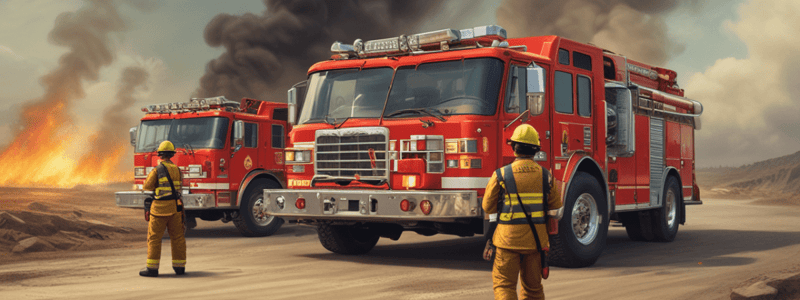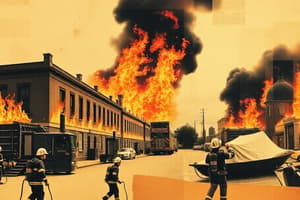Podcast
Questions and Answers
What is the primary purpose of the Rules of Engagement developed by the International Association of Fire Chiefs?
What is the primary purpose of the Rules of Engagement developed by the International Association of Fire Chiefs?
- To implement the Incident Management System
- To determine the safest approach for tactical operations (correct)
- To reduce the number of fire stations in a city
- To increase the number of firefighters on a scene
What is a key objective of the Incident Commander during a fire operation?
What is a key objective of the Incident Commander during a fire operation?
- To rapidly conduct or obtain a 360 degree size-up of the incident (correct)
- To conduct a 180 degree size-up of the incident
- To determine the number of firefighters needed to combat the fire
- To determine the best escape route for occupants
What should the Incident Commander consider when determining whether to commit to a rescue operation?
What should the Incident Commander consider when determining whether to commit to a rescue operation?
- The type of fire suppression system in use
- The possibility of occupants surviving the fire (correct)
- The age of the building
- The number of firefighters available to assist
What action should the Incident Commander take if an assigned objective cannot be achieved due to conditions?
What action should the Incident Commander take if an assigned objective cannot be achieved due to conditions?
Why should special consideration be given to abandoned or dilapidated buildings during a fire operation?
Why should special consideration be given to abandoned or dilapidated buildings during a fire operation?
When should firefighters be committed to search and rescue operations?
When should firefighters be committed to search and rescue operations?
What is the primary consideration before developing an action plan?
What is the primary consideration before developing an action plan?
What is the purpose of ongoing progress reports during a fire operation?
What is the purpose of ongoing progress reports during a fire operation?
When should firefighters consider a Defensive Strategy?
When should firefighters consider a Defensive Strategy?
What is the importance of maintaining accurate accountability of firefighter location and status?
What is the importance of maintaining accurate accountability of firefighter location and status?
What should be done if a firefighter raises a safety concern?
What should be done if a firefighter raises a safety concern?
What is a critical component of all working fires?
What is a critical component of all working fires?
Flashcards are hidden until you start studying
Study Notes
Rules of Engagement for Firefighter Safety
- Developed by the International Association of Fire Chiefs to assist Incident Commanders in risk assessment and decision-making
- Adopted by Toronto Fire Services as a decision tree to determine whether a fire is fought offensively or defensively
Objectives
- Rapidly conduct or obtain a 360-degree size-up of the incident to determine the safest approach for tactical operations
- Obtain an early 360-degree survey and risk assessment to prioritize occupant survival and firefighter safety
- Determine the Occupant Survival Profile to decide on search and rescue operations
NO GO Situations
- If an assigned objective cannot be achieved due to conditions, revise the Incident Action Plan
- If the occupants cannot survive, do not commit to a rescue; obtain fire control before searching
- If the fire has or will destroy the structure, adjust the action plan
- If there are not enough resources to safely support and protect firefighters, consider a Defensive Strategy
Risk Assessment and Action Plan
- Develop a safe action plan by completing a thorough risk assessment before placing firefighters at risk
- Conduct ongoing progress reports to provide critical information for decision-making and revisions to the action plan
- Prevent committing firefighters to high-risk tactical objectives that cannot be accomplished safely
- Prioritize savable property and lives, and extend measured risk to protect and rescue them
Safety Considerations
- Stop, evaluate, and decide on reported unsafe practices and conditions that can harm firefighters
- Allow any member to raise an alert about a safety concern without penalty
- Maintain frequent two-way communications and keep interior crews informed of changing conditions
- Obtain frequent progress reports and revise the action plan accordingly
Accountability and Support
-
Ensure accurate accountability of all firefighter locations and status
-
Maintain a constant and accurate accountability of firefighter locations and status
-
Always have a Rapid Intervention Team in place at all working fires
-
Provide Firefighter rehab services, including hydration, at all working fires
THE CHECKLIST
• Rapidly Conduct, or Obtain, a 360 Degree Size‐Up of the Incident.
• Determine the Occupant Survival Profile.
• Conduct an Initial Risk Assessment and Implement a SAFE ACTION PLAN.
• If You Do Not Have The Resources to Safely Support and Protect Firefighters -Seriously Consider a Defensive Strategy.
• DO NOT Risk Firefighter Lives for Lives or Property That Can Not Be Saved -
Seriously Consider a Defensive Strategy.
• Extend LIMITED Risk to Protect SAVABLE Property.
• Extend Measured Risk to Protect and Rescue SAVABLE Lives.
• Act Upon Reported Unsafe Practices and Conditions That Can Harm Firefighters. Stop, Evaluate and Decide
• Maintain Frequent Two‐Way Communications and Keep Interior Crews Informed of Changing Conditions.
• Obtain Frequent Progress Reports and Revise the Action Plan.
• Ensure Accurate Accountability of All Firefighter Location and Status.
• If, After Completing the Primary Search, Little or No Progress Towards Fire
Control Has Been Achieved ‐ Seriously Consider a Defensive Strategy.
• Always Have a Rapid Intervention Team in Place at All Working Fires
• Always Have Firefighter Rehab Services in Place at All Working Fires.
Studying That Suits You
Use AI to generate personalized quizzes and flashcards to suit your learning preferences.




